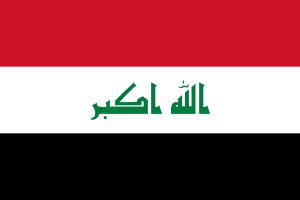
| Colors | HEX Code | RGB | CMYK |
|---|---|---|---|
| Red | #CE1126 | 206, 17, 38 | 0, 92, 82, 19 |
| White | #FFFFFF | 255, 255, 255 | 0, 0, 0, 0 |
| Green | #007A3D | 0, 122, 61 | 100, 0, 50, 52 |
| Black | #000000 | 0, 0, 0 | 0, 0, 0, 100 |
The flag of Iraq is made of three equal horizontal stripes. The upper stripe is colored red. The middle stripe is colored white; the bottom stripe is colored black. In the center of the white stripe, there is an inscription in the Kufic Script “Allah Akbar” or “God is Great”, placed horizontally on the flag and is colored green.
Meaning of the Iraqi Flag
The red color to red represents the willingness to shed blood. The green symbolizes the Arab fields. The black signifies battles, and the white is for purity of actions.
History of the Iraqi Flag
After World War I, Iraq was placed under British occupation, leading to the establishment of a monarchy under Faysal bin Ali, whose father ruled Hijaz. King Faysal I introduced a flag in 1921, reminiscent of his father’s, featuring black, white, and green stripes with a red triangle at the hoist. By 1924, the flag underwent a revision, replacing the white triangle with two green seven-pointed stars, symbolizing the Arab and Kurdish communities.
The monarchy’s overthrow in 1958 prompted the adoption of a new flag in 1959, characterized by black, white, and green bands, augmented by a central emblem depicting a yellow sun with eight red rays, representing the Kurds. In 1963, a flag representing Arab liberation emerged, incorporating colors common to many Arab nations, with three central stars symbolizing Iraq’s desire for unity with Egypt and Syria. Saddam Hussein modified the flag in 1990, adding the Arabic phrase “God is Great” in response to the Persian Gulf War. Finally, in 2004, the flag underwent its last transformation, removing the central stars from its design.